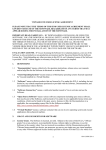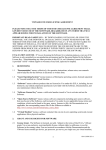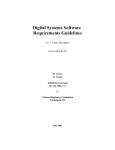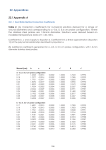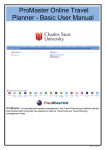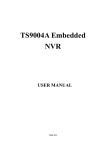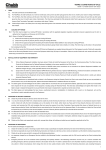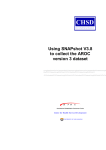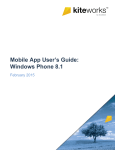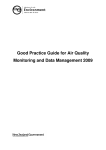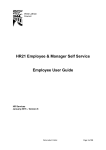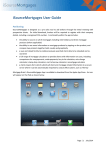Download School Student Transport Scheme
Transcript
School Student Transport Scheme Bus operators manual Table of Contents 1. FOREWORD 4 2. INTRODUCTION 5 2.1 Objective 5 2.2 Legislative basis for the Scheme 5 2.3 Overview of services subsidised under SSTS 5 2.4 Administration by Transport NSW 6 2.5 Choice of route and transport mode 7 3. RESPONSIBILITIES OF BUS OPERATORS 8 4. ELIGIBILITY CRITERIA 9 4.1 Standard eligibility criteria 9 4.1.1 School students 9 4.1.2 TAFE students 9 4.2 Special eligibility criteria 10 4.2.1 Students whose parents have joint custody 10 4.2.2 Transport of students to agricultural plots 10 4.2.3 Students attending school interstate 11 4.2.4 Students who temporarily attend a different school 11 4.2.5 Students with disabilities 11 4.3 Assessing Eligibility 5. 11 4.3.1 Establishing the distance between home and school 11 4.3.2 Applications on walking grounds 12 4.3.3 Applications on health and safety grounds 12 4.3.4 Applications on health grounds 12 4.3.5 Applications on safety grounds 13 4.4 Requirement for students to reapply for subsidised transport 13 4.5 Withdrawal of passes 13 4.5.1 Retention of passes despite ineligibility 14 4.5.2 Ineligibility due to misrepresentation 14 4.5.3 Unauthorised use of a pass 14 STUDENTS’ RESPONSIBILITIES 15 5.1 Code of Conduct 15 PAGE 2 5.1.1 Classification of misbehaviour 6. 7. 8. 9. 15 BUS SERVICES 17 6.1 Key elements of the bus contract system 17 COMMERCIAL BUS SERVICES 18 7.1 Commercial services application process 18 7.2 Changes to student details 19 7.3 Commercial transport replacement passes 19 7.4 Audit and payment process for commercial operators 20 7.4.1 Progress payments 20 7.4.2 Audits 20 7.4.3 Adjustments 21 7.5 Deductions from payments when services do not operate 21 NON-COMMERCIAL BUS SERVICES 22 8.1 Non-commercial application process 22 8.2 Non-commercial SSTS replacement passes 23 8.3 Payment processing for non-commercial services 23 UNSUCCESSFUL APPLICATIONS 24 9.1 Review by Transport NSW 24 9.2 SSTS Appeals Panel 24 10. APPENDICES 25 10.1 Appendix A – Feedback Sheet 25 10.2 Appendix B – Transport NSW forms 25 11. ENQUIRIES 31 PAGE 3 1. Foreword The purpose of this manual is to provide operators with an overview of the policies and related procedures that govern the administration of the School Student Transport Scheme (SSTS). The manual not only provides bus operators with a guide as to their role and responsibilities in relation to the SSTS administration in NSW, it also outlines the roles and responsibilities of Transport NSW and schools. The manual is intended to reflect current practice in the administration of the SSTS and will be updated as required. An SSTS Working Party, comprising representatives from the education sector, the bus industry and relevant Government departments, will assist with identifying areas for improvement. This manual includes a feedback sheet (at appendix A) to enable you to provide comments and ideas on how SSTS administration can be improved. I encourage your to use this mechanism which will assist Transport NSW in identifying and implementing service improvements. Operators play a key role in the successful delivery of the SSTS to students in NSW. I trust that the partnership between operators, schools and Transport NSW will continue to strengthen as we look at ways of further improving and streamlining the management of the Scheme. Michael Deegan Director General Transport NSW September 2002 PAGE 4 2. Introduction 2.1 Objective The objective of the NSW School Student Transport Scheme (SSTS) is to facilitate the transport of eligible students to their schools. In pursuing this objective Transport NSW will endeavour to ensure that: all NSW school students who do not live within reasonable proximity to the school attended have access to education by the provision of subsidised travel to and from school in providing travel assistance, the State’s resources are expended in the most efficient and effective manner, noting that: ¾ subsidised travel is available only for travel between home and the school attended and on school days only, and ¾ it is necessary to manage bus and rail capacity during times of peak demand to seek to meet the reasonable needs of all users. 2.2 Legislative basis for the Scheme The Transport Administration Act 1988 provides for the administration of Government subsidised travel concessions, such as the SSTS, in s.39: (1) The Director-General shall administer, or arrange for the administration of, any scheme approved by the Minister for Government subsidised travel concessions on passenger services. (2) Payments required to be made in accordance with any such scheme shall be made from such money as may be provided by Parliament for the purpose. Thus the administration of SSTS, within the policy framework set by Government, is a function of the Director General of Transport NSW. 2.3 Overview of services subsidised under SSTS The SSTS provides eligible school students who are residents of NSW with subsidised travel between their normal place of residence and the school attended. The SSTS is administered by Transport NSW, which is responsible for implementing government policy concerning the transport of children to government and non-government schools. Transport services included in the SSTS are: government rail (CityRail and CountryLink) government bus and ferry services (STA, excluding Jet Cats and tourist services such as Sydney Explorer) private bus and ferry services long distance coaches private vehicle conveyance (PVC) air travel for Lord Howe Island high school students only. PAGE 5 In general, subsidised travel under the SSTS is only available when it is: undertaken during standard school days as per the Department of Education and Training school calendar by the shortest and most economical route between the student’s normal place of residence and the school attended from the boarding point closest to a student’s home by the most appropriate approved route to the appropriate set-down point taken within a reasonable period of the normal range of school commencement and finish times on Monday to Friday (except for boarding school students). The periods 7.30 a.m. to 9.30 a.m. and 3 p.m. to 5 p.m. must be observed by operators, though individual operators can extend these periods at their discretion. The payment model assumes only one forward and one return trip per each school day. Subsidised travel is not available for: attendance at Vocational Education and Training (VET) in Schools educational excursions sporting activities away from the school work experience programs Saturday schools for community languages operated by the Department of Education and Training language/culture classes operated by various ethnic church and community groups pre-schools or child care centres, whether operated privately or by the Department of Education and Training formal and informal before and after school care nominated carers’ residences mini-schools, except for geographically isolated, full-time distance education students. 2.4 Administration by Transport NSW Transport NSW administers the SSTS through its Contracts and Compliance offices based in Parramatta, Wollongong and Newcastle. NSW is divided into three areas and each office undertakes the tasks associated with management of the Scheme within its area. See the back cover for a map of the areas covered by the respective Contract and Compliance Offices. The Bus and Ferry Reform Group within Transport NSW is responsible for identifying and negotiating major strategic improvements to the arrangements for the provision of bus services in NSW. This includes a focus on service development, performance and efficiency issues. In this capacity the Bus and Ferry Reform Group is responsible for identifying and implementing SSTS improvements and reform, in line with Government policy. To assist with this task, an SSTS Working Party chaired by Transport NSW has been established to ensure a coordinated and consultative approach to improving the administration and effectiveness of the SSTS. The Working Party includes representatives from Transport NSW, the Bus and Coach Association, Department of Education and Training, Treasury, Cabinet Office, Catholic Education Commission and the Association of Independent Schools. PAGE 6 2.5 Choice of route and transport mode In some situations students have an option to travel on bus, rail, or ferry. As a rule, students must travel by rail in preference to bus or ferry travel because of cost and capacity issues. Bus operators are expected to keep this in mind when assessing applications for the SSTS. During its audit process of operators Transport NSW ensures that students are travelling on an appropriate route and transport mode. Issues such as convenience to the student and time taken to travel to school may be taken into account. A student should use the same mode of transport and route in the morning and afternoon five days a week. For example, rail cannot be used just in the mornings and a bus in the afternoons. Where students need to access more than one type of transport to get to school (e.g. bus and train) they must apply for each type of transport on a separate application form. PAGE 7 3. Responsibilities of bus operators While Transport NSW has the prime responsibility for the management of the SSTS, operators have a key role in the process. In simple terms the roles and responsibilities of operators are to: liaise with schools where applicable on issues, such as school finishing times and student holiday periods, to jointly ensure students receive an appropriate bus service liaise with schools to ensure that they are aware of the appropriate forms that students need to complete to be considered for the SSTS using Transport NSW radial distance maps, review SSTS applications that are forwarded by schools to ensure they are from eligible students process applications and inform eligible students that they are able to travel on a bus service provided by the operator. Commercial operators and some non-commercial operators then issue a pass. in the instances where student applications do not meet the prescribed eligibility criteria, inform students and their parents of the reasons why their applications were denied and advise them of the avenues available in appealing decisions keep a copy of an eligible student application for 7 years from the date of the last payment made for that student provide details to Transport NSW at the end of each semester (Term 2 and Term 4) of eligible students using their services, so that operator payments can be processed for commercial bus operators maintain arrangements with schools to provide information on a monthly basis (every third Wednesday of the month from February to December) about the changed circumstances of students. This is to ensure that student information is up to date and that they continue to meet the eligibility criteria. (Audits undertaken by Transport NSW are used to check students’ eligibility status and can lead to adjustments to operator payments). For specific details on these responsibilities, please refer to the following sections. PAGE 8 4. Eligibility criteria 4.1 Standard eligibility criteria School students may be eligible for subsidised travel under the SSTS provided they are: residents of NSW 4 years 6 months of age or older and enrolled in a day or boarding school (either government or non-government as defined under the Education Act 1990) or TAFE. The eligibility criteria are linked to the student’s school year and the distance between the student’s home and the school attended. Overseas students who are entitled to receive free education in NSW are also entitled to access the SSTS provided they meet the other criteria. Those not entitled to free education in NSW are not entitled to benefits under the SSTS. In these situations schools are responsible for determining eligibility. 4.1.1 School students School students are eligible for subsidised transport if they: attend infants school (K–2) irrespective of distance from home to school or attend primary school (Years 3–6) and reside more than 1.6 kilometres (radial distance) from the school attended measured on a radius from the centre of the school site, or 2.3 kilometres or more by the most direct practicable walking route to the nearest point of physical entry to the school or attend secondary school (Years 7–12) and live more than 2.0 kilometres (radial distance) from the school attended measured on a radius from the centre of the school site, or 2.9 kilometres or more by the most direct practicable walking route to the nearest point of physical entry to the school or attend any year at school where the only form of transport to that school is by private ferry. School students are eligible for private vehicle conveyance (PVC) if they: • meet one of the eligibility criteria listed above • and • live in an area where there is no public transport for all or part of the journey. (Part of the journey is defined as more than 1.6 km walking distance from the place of residence to the nearest transport pick-up point.) 4.1.2 TAFE students TAFE students are eligible for subsidised transport if they: are enrolled in a full time TAFE course, i.e. a course with a duration of 12 weeks or more requiring a minimum of 20 hours attendance over at least 4 days per week PAGE 9 and are under 18 years of age at the 1 January of the year of application and live more than 3.2 kilometres from the college by the most practicable walking route and are not employed and attend the TAFE college nearest their home at which enrolment is available. TAFE students are eligible for PVC if they: meet all the eligibility criteria listed above and live in an area where there is no public transport available 4.2 Special eligibility criteria There are some students who are eligible for subsidised travel under the SSTS for reasons other than the standard criteria outlined above. Some of the criteria that operators may encounter are detailed below. 4.2.1 Students whose parents have joint custody Where a Residency Order (an order from the Family Court that states with whom the child should live) has been awarded jointly to both parents and the Order specifies that the child must reside¹ with each parent (regardless of what time sharing pattern or time periods are specified), the student may be eligible for subsidised school transport in relation to both residences. Approval is subject to the normal eligibility criteria being met (each residence is to be tested separately) and the production of satisfactory evidence of the terms of the Residency Order (or Custody Order prior to 1996). If the matter has not gone to the Family Court, a statutory declaration from each parent that specifies time sharing arrangements for the child residing at both addresses should be submitted. This policy is not intended to provide for subsidised travel to or from different residences by eligible students on weekends only, for example to cover weekend access visits, and is not to be interpreted in this way. 4.2.2 Transport of students to agricultural plots Secondary students studying agriculture do not always have access to an agricultural plot or farm located on the school site or within a reasonable walking distance of the school. Where schools apply for transport to agricultural plots or farms under the SSTS, transport must be authorised by Transport NSW in accordance with the following guidelines before the service is implemented: ¹ For SSTS policy purposes “reside” means that the child enjoys the physical amenities of a home maintained by each parent and stays overnight with the parent when using their subsidised pass to travel between that home and school. PAGE 10 Costs are met only where the plot is not within reasonable walking distance of the school as determined by Transport NSW. Assistance applies to one plot only and may not be extended to travel to other plots owned by the school or private farms. Cost are met for only one (1) trip per week for Year 7 students and a maximum of two (2) trips for all other students (Years 8-12). Travel must be at the cheapest rate for the most practicable route available. 4.2.3 Students attending school interstate Students who live in NSW and attend school in another state (QLD, ACT, VIC and SA) are eligible for subsidised transport provided they meet the standard eligibility criteria. Eligible students are transported over the border to their school by a NSW non-commercial or commercial bus service. They may also be transported to a drop-off point in the bordering state and then take the bordering state’s commercial or non-commercial transport for the remainder of the trip to school. In these cases, Transport NSW is usually invoiced for this travel. 4.2.4 Students who temporarily attend a different school In some circumstances special courses are run for students who have specific academic needs, e.g. learning English. Generally, these courses are not run in the school normally attended by the student—so the student may be required to attend a different school full-time for one or more terms. In these cases, the student is eligible for subsidised transport to their temporary school provided they meet the standard eligibility criteria and surrender their existing pass. Schools must inform operators on the third Wednesday of each month of any change in a student’s circumstances (including any temporary arrangements). Subsidised travel is not available for attendance at a special class or school for part of the week or part of the day. 4.2.5 Students with disabilities Students with a disability who are able to use public transport and meet the standard SSTS eligibility criteria are able to be transported under the SSTS. 4.3 Assessing Eligibility 4.3.1 Establishing the distance between home and school The standard eligibility criteria for subsidised travel under the SSTS include radial and walking distance tests. Transport NSW supplies maps with the relevant radial distances (1.6 and 2.0 kilometres) marked on them (and in some instances street lists are provided) for use by schools and operators when checking the eligibility of primary and secondary school students. Transport NSW alone will determine whether a student is eligible on walking distance grounds. PAGE 11 4.3.2 Applications on walking grounds Students who reside inside the school radial distance may still be eligible for subsidised transport if they have to walk 2.3 km (primary students), or 2.9 km (secondary students) or more to the nearest point of entry to the school property using a suitable walking route. In such cases parents/guardians may apply in writing to their Transport NSW Contracts and Compliance office. The letter must provide the following information: the student’s full name and address as enrolled in the school the school name and address a list of all the streets along the walking route from home to school the distance travelled specified to the nearest 100 metres. Applications on walking distance grounds can only be authorised by Transport NSW and are assessed on an individual basis. 4.3.3 Applications on health and safety grounds Transport operators assess eligibility for subsidised transport on the basis of the radial distance from the student’s home to the school. Where the operator has determined that a student is not eligible for subsidised transport, the operator provides the parents/guardians with a written reason for the decision and a copy of the document Information for Parents and Guardians. (See Appendix B for a copy.) Please Note: Applications on health and safety grounds can only be authorised by Transport NSW. 4.3.4 Applications on health grounds Students not eligible for subsidised transport under the standard eligibility criteria may be deemed eligible for subsidised transport if they are unable to walk to school due to a health condition. The subsidy may be in the form of a temporary travel pass or Private Vehicle Conveyance subsidy. Most passes/approvals are issued for a stated period only and parents/guardians must apply for a renewal in order to extend the student’s eligibility past this period. In order to apply for subsidised transport for health reasons, the parents/guardians must obtain a form, Transport NSW School Student Transport Scheme Medical Certificate, which is available from Transport NSW or operators. (See Appendix B for a copy.) Parents/guardians must complete Part A and arrange for Part B to be completed by a qualified registered medical practitioner. The completed form is sent to the Transport NSW Contracts and Compliance office at the address on the form. Upon receipt the Contracts and Compliance office reviews the application, and if appropriate, approves subsidised transport for a specified period. PAGE 12 4.3.5 Applications on safety grounds Students not eligible for subsidised transport under the standard eligibility criteria may be eligible for subsidised transport if their walking route to school is considered unsafe. This may be due to temporary road closures or construction, or may be a permanent problem. In order to apply for subsidised transport on safety grounds, parents/guardians must apply in writing to the Transport NSW Contracts and Compliance office. The letter must provide the student’s full name and home address as enrolled at the school, the name and address of the school, a list of the streets along the walking route, the distance travelled to the nearest 100 metres, and provide details of possible problem locations. Upon receipt of the letter the Contracts and Compliance office will investigate the claim and make a decision as to eligibility. Subsidised transport approvals on safety grounds are for a specified period and are subject to periodic review by Transport NSW. If subsidised transport is not approved, parents/guardians will be provided with information on how they can apply for an independent review of the decision. The School Student Transport Scheme Appeals Panel will review the decision. 4.4 Requirement for students to reapply for subsidised transport Students are required to reapply for subsidised transport in the following situations: change of address change of school change of name infant students progressing to year 3 year 6 students progressing to high school change of school location change of route, which is initiated by the student. If a student receives a new pass during the school year due to a change of address, bus route or name, the student must surrender the old pass to the school which then returns it to the relevant transport operator. If the pass is lost, the parent/guardian must provide a statement to this effect when applying for the new pass. Schools must provide the operator with information, on the third Wednesday of each month, regarding any change in a student’s circumstances (see Appendix B for the form schools use to provide this information). 4.5 Withdrawal of passes Transport NSW reserves the right to withdraw a subsidised travel pass in particular circumstances, for example if it was issued in error, after a change of circumstances or due to misrepresentations by an applicant (e.g. giving a false address). If Transport NSW decides to withdraw a subsidised travel pass, it will write to the student’s parent/guardian and school and to the relevant transport operator(s) setting out the reasons why and giving instructions for the surrender of the pass. PAGE 13 4.5.1 Retention of passes despite ineligibility An ineligible student may be permitted to retain and use a pass to the end of a semester (Term 2 or Term 4) if it has been on issue for a period of more than five weeks from the beginning of a semester. This would be the case where ineligibility was due to a processing error or change in circumstances. For example, a student may become ineligible because of a change in the street network, the lifting of safety restrictions or other circumstances that affect eligibility. This concession reflects the fact that commercial bus operators are entitled to receive a full semester fare if a student they have issued with a subsidised travel pass was enrolled at the relevant school for more than five weeks in the semester. 4.5.2 Ineligibility due to misrepresentation In cases involving misrepresentation the operator will still receive the full semester fare provided that more than five weeks have elapsed, except where it is clear that the operator should have detected the misrepresentation. 4.5.3 Unauthorised use of a pass If a student is found to be using a pass that does not belong to them, it will be confiscated and may be cancelled (‘hot listed’) by the operator. PAGE 14 5. Students’ responsibilities All students are to behave in a manner that ensures both their comfort and safety and the comfort and safety of other passengers. Transport NSW has developed a Code of Conduct for students travelling on buses. It was developed in consultation with the Department of Education and Training, relevant principals’ associations, the Catholic Education Commission, the Association of Independent Schools, the Bus and Coach Association and relevant unions and parent representative groups. In addition, CityRail has developed a safety policy for students travelling on trains. These codes were designed to help ensure the safety and comfort of everyone. Students who misbehave on buses or trains may be subject to penalties based on the severity of the misbehaviour. Transport NSW has published Guidelines for Managing Schools Students’ Behaviour on Buses – A Code of Conduct for students and procedures for bus drivers, operators, school principals and parents/carers. This publication can be found on the department’s website at www.transport.nsw.gov.au These guidelines form the basis upon which bus operators must develop and apply appropriate procedures to manage breaches of the Code of Conduct. They ensure that all incidents of inappropriate behaviour are dealt with in a fair and consistent manner, no matter which bus operator or school is involved. 5.1 Code of Conduct The Code of Conduct states that students will: behave safely at all times respect the needs and comfort of other passengers behave appropriately at all times (e.g. no use of offensive language, fighting, spitting, placing feet on seats or throwing things in or from the bus) protect bus property and report any vandalism show their travel passes or tickets to the driver on boarding and when requested only use the travel pass for its intended purpose maintain possession of the travel pass at all times follow the driver’s instructions about safety on the bus (e.g. instructions on where to sit) adhere to the law that bans smoking on buses only eat or drink (other than water) on the bus with the permission of the bus operator keep arms, legs and other parts of their bodies inside the bus only attract the attention of the driver in the case of an emergency. 5.1.1 Classification of misbehaviour To promote consistency and fairness in responding to the Code of Conduct, misbehaviour is categorised as unacceptable behaviour, dangerous behaviour, or highly dangerous behaviour. Each of these categories has different penalties attached, as follows: Unacceptable behaviour involves actions such as: • distracting the driver by persistent noise • failing to show a travel pass, except where passes are not issued (i.e. non-commercial services in rural areas) PAGE 15 • eating or drinking (other than water) on the bus (unless for medical reasons or with the • • • • • • written permission of the bus operator) smoking spitting using offensive language minor harassing and bullying of other passengers pressing the stop button continually damaging property. Penalty: May lead to the loss of subsidised school transport privileges for up to ten (10) school days. Students may be banned from travelling on buses. Dangerous behaviour involves actions such as: • serious harassing and bullying of other passengers • allowing any part of their body to protrude from the bus whilst the bus is in motion • stopping others from disembarking at their stop • verbally threatening the driver • standing on steps or in areas not set aside for standing and refusing to sit down • pushing and shoving when boarding or exiting the bus • swinging on bus handrails • throwing objects inside or out of the bus • fighting with other passengers • causing significant damage to property in buses • using matches/lighters • carrying dangerous items. Penalty: May lead to the loss of subsidised school transport privileges for up to ten (10) school weeks. Students may be banned from travelling on buses. Highly dangerous behaviour involves actions such as: • pushing students out of the doors or windows • interfering with the driving controls or emergency door release • assaulting the driver or other passengers • interfering with safety equipment • recklessly or negligently endangering the safety of other passengers or themselves • destruction of bus property. Penalty: May lead to the loss of subsidised school transport privileges and possible court action or police prosecution. Students may be banned from travelling on buses. PAGE 16 6. Bus services The Passenger Transport Act 1990 provides that all regular passenger bus services must be carried out under contract between an accredited operator and the Director General of Transport NSW. The Act identifies two kinds of contracts: commercial – remuneration is to be derived from revenue generated by passengers’ fares non-commercial – remuneration is by payment from the Government on an ‘agreed contract price’. 6.1 Key elements of the bus contract system Under current legislation and regulation, commercial and non-commercial school operators enter into five-year contracts. Remuneration of both commercial and non-commercial contracts is reviewed on an annual basis by the Independent Pricing and Regulatory Tribunal (IPART) which reviews, amongst other matters, any changes in the cost of providing the service. IPART then makes a recommendation to the Director General of Transport NSW including any changes to commercial service fare levels and remuneration for non-commercial contracts. The payment formula for commercial contracts factors in any changes to the authorised fares, the number of passes on issue, an estimated pass usage rate and the average number of school days per year. The payment formula for non-commercial services is a total ‘revenue requirement’ for providing the service. Conditions for the quality of the service to be provided are contained in the contract. These include an average age of bus requirement, vehicle and driver standards and information to be provided to the public. Contracted operators are independent from Transport NSW and are responsible for the operation of their own service. PAGE 17 7. Commercial bus services Commercial bus services operate under a commercial contract and provide fare based services for the entire community. As part of this service, they must carry students to and from home and school. They may carry the students on regularly scheduled buses or may operate special buses to provide transport to a group of students to a particular school (generally known as a ‘school special’). The decision to run a ‘school special’ is made by the operator and is based on student numbers/locations and bus capacity. 7.1 Commercial services application process Applications for subsidised travel by students on government bus services (STA) are made by parents/guardians on the form, Application for Travel Under the School Student Transport Scheme Travel on Government Bus/Ferry Services. Applications for subsidised travel by students on privately owned bus services are made by parents/guardians on the form, Application for Travel under the School Student Transport Scheme – Travel on Private Bus/Private Ferry Services. TAFE students apply on the form, Application for Travel by Eligible TAFE Students. All forms are available from the school or TAFE. Operators process current pass holder applications as follows: 1. At the beginning of each year each operator creates a new file containing the details of all students who were issued a pass the previous year, except for students who have finished years 2, 6 and 12. These are years when eligibility criteria change and new applications for the SSTS must be made. (See the Section 4.1) 2. The operator then issues passes for these students and sends them to the schools for distribution to students. For new students, applications are processed as follows: 1. The parent/guardian obtains the form(s) from the school. 2. The parent/guardian completes Part A of the relevant form(s), which contain student information, and returns them to the school. 3. When the school receives the applications, the principal or a delegated member of staff ensures that Part A has been completed and confirms enrolment at the school. They then assess the eligibility of the student for subsidised transport by using radial maps (or street lists) supplied by Transport NSW. 4. If a student appears to be eligible for a pass, the principal or their delegate signs and dates Part B (which confirms this), sends the original application to the relevant operator and retains the ‘school copy’ in the school files. 5. If a student is clearly not eligible for a pass, the school delegate returns the application form to the parent/guardian. If unsure of eligibility, the principal or their delegate submits the application to the operator. PAGE 18 On receipt of the application the operator processes it as follows: 1. The operator re-checks radial distance eligibility using maps supplied by Transport NSW and ensures that the student is travelling on an appropriate mode of transport. (See Section 2.4). If the student is not eligible for a pass on either radial distance criteria or appropriate transport mode, the operator returns the application form to the parent along with the reason the application was declined. A document entitled Information for Parents and Guardians must also be sent. (See Appendix B for a copy.) This document advises the options available for a review of the decision by Transport NSW on health, safety or walking distance grounds. 2. If the student is eligible for a pass: ¾ STA enters the students travel information (eg. distance travelled, fare code, route number and type of service) into its computer system and sends the relevant information to the printer so that the passes can be printed. STA sends the passes to the schools along with information leaflets and a supply of blank application forms. ¾ Private operators either enter information into their computer system or complete Part C of the application form regarding distance travelled, fare code, route number and type of service, and then issues the passes and send them to the school for distribution. 3. The operator keeps the original application on file for 7 years from the time of the last payment to the operator. If uncertainty exists as to a student’s eligibility, the operator should not issue a school travel pass. The application should be referred to the relevant Contracts and Compliance office for consideration. If an operator has failed to refer doubtful applications to the Contracts and Compliance office and has issued passes in error, Transport NSW will not pay the operator for these passes. 7.2 Changes to student details Operators should liaise with schools to ensure that the schools regularly provide information on any changed circumstances regarding students details, e.g. when students change school or address. It is expected this will be done on a monthly basis (every third Wednesday of the month from February to December) to ensure that operator payment claims to Transport NSW are accurate. Schools have been informed that they should provide monthly information to operators on changed student details. Transport NSW has provided schools with copies of forms that they must use to forward changes on student details. See Appendix B for copies of these forms. 7.3 Commercial transport replacement passes The operator meets the initial cost of producing passes. Transport NSW has authorised operators to charge an administration fee to cover replacement of lost, stolen or damaged passes. Operators produce their own replacement application request forms. Parents/guardians must contact the operator directly for a replacement form. PAGE 19 For STA only, parents/guardians can get an Application for Replacement of School Bus/Ferry Pass or TAFE Bus Pass from the relevant school or TAFE. Once the form is completed (with the school or TAFE having signed it), parents/guardians have the option of either mailing the completed form along with the replacement fee to the address on the form or lodging the form in person. If the form is lodged in person, STA will issue an interim pass. All replacement passes are returned to the school or TAFE for distribution to the student concerned. If a student requests more than two (2) replacement passes in one year, STA will investigate the reason prior to issuing a third pass. This is to prevent students from inappropriately disposing of their passes and then applying for replacements. For private operators, replacement passes are either sent directly to the school or the student’s home address or they are issued ‘over the counter’ by the operator. 7.4 Audit and payment process for commercial operators 7.4.1 Progress payments Five progress payments are made to operators each semester. Payments are made in February, March, April, May, June, August, September, October, November, and December and are based on what was paid for during the previous semester. At the end of each school semester the operator sends a ‘wash up’ claim for each contract to the relevant Contracts and Compliance office. The ‘wash up’ is the difference between what was paid and what is owed to the operator or to Transport NSW. This difference is due to changes in student numbers, etc. The claim is used to calculate the amount of this difference so that the final semester payment may be made. The operator makes this claim by computer disk or on paper. The claim must include: a list of all students carried student addresses sections claimed school names school codes semester fare 7.4.2 Audits The Contracts and Compliance office then randomly selects student records to be audited for eligibility (radial distance and transport mode). Where a claim is for 500 or fewer students, 50 student records are selected. Where the number of students is greater than 500, 100 student records are selected. The Contracts and Compliance office conducts a full check of the sample records for eligibility and the fare being claimed by the operator. During this process schools are required to verify student details. Over and underpayments for each student are recorded. Students who have left the school are listed separately. Schools are required to sign each page of the list of students verified during the audit. PAGE 20 7.4.3 Adjustments The semester return is adjusted as necessary using the information obtained from the audit. There can be two types of adjustments to the return: One is an actual adjustment to directly reflect the number of students in the audit sample who are no longer at the school or who have changed home address. This adjustment— known as an attendance adjustment—applies from the date that the student’s enrolment status changed. This adjustment is not extrapolated across the contract if the school did not provide information on the change in the student’s details or enrolment to the operator. If the school provided written evidence of a notification to the operator of these changes, the adjustment is made across the whole claim. The second type of adjustment is for over or underpayments due to incorrect fares/sections being claimed by the operator. This adjustment—called a sample adjustment—is extrapolated across the return as it can be assumed that the operator will have made similar errors across the SSTS population. Note that the adjustment may increase or decrease the amount of the semester return. 7.5 Deductions from payments when services do not operate When a passenger bus service used by school students does not operate, a deduction is made when the service does not operate for reasons that are regarded as risks normally accepted in any commercial undertaking. These reasons include industrial action, vehicle breakdown, accident, failure of driver to report for duty, or unavailability of fuel or spares. A deduction is not made when a service is prevented from operating by an ‘Act of God’, (e.g. events such as bushfires, floods, heavy snowfalls, and other natural disasters). PAGE 21 8. Non-commercial bus services Where there is no commercial contract for regular route services, Transport NSW enters into a non-commercial contract with an accredited bus operator to conduct a dedicated school bus service along a specific route, which has been approved by Transport NSW. Non-commercial bus services operate mainly in rural areas. Non-commercial bus services may also take fare paying passengers as long as there is sufficient space on the bus, SSTS students are not displaced and the approved route is not altered. Consideration may only be given to establishing a new non-commercial school bus service where at least 15 (fifteen) school age students reside 3.2 kilometres or more by the shortest most practical route to their school or local route bus service and the majority live beyond 8 kilometres from the school. The number of students is to be calculated on the basis that all children use the bus each morning and afternoon each week. Children who only use buses at the beginning and end of each week (boarders) are not to be counted for the purpose of determining eligible numbers for the establishment, maintenance or variation of a non-commercial service. Every effort must be made to accommodate the students concerned on services already established. If possible, minor alterations to such services may be required to accommodate additional students. 8.1 Non-commercial application process Applications for subsidised transport by students on privately owned non-commercial passenger bus/ferry services are made by parents/guardians on the form, Application for Travel by Eligible School Students – Travel on Private Bus/Private Ferry Services. TAFE students are to complete the form, Application for Travel by Eligible TAFE Students. (Forms are available from schools or TAFE colleges.) Applications and passes are processed as follows: The parent/guardian obtains the form(s) from the school. The parent/guardian completes Part A of the relevant forms, which contain student information, and returns it to the school. Upon receipt, the school principal or a delegated member of staff ensures that Part A has been completed, and using the radial maps supplied by Transport NSW determines whether the student meets the radial distance eligibility criteria for subsidised transport. If the student appears eligible for subsidised transport, the principal or their delegate signs and dates Part B to confirm this, sends the original application to the appropriate operator and retains the ‘school copy’ in the school files. If the student is clearly not eligible for a pass, the principal or their delegate returns the application form to the parent/guardian. If the eligibility is unclear, the principal or their delegate submits the application to the operator for determination. On receipt of the application, the operator processes the pass as follows: 1. The operator re-checks radial distance eligibility using maps supplied by Transport NSW. If the student is not eligible for subsidised transport on radial distance criteria, the operator returns the application form to the parent along with the reason the application was declined. A document entitled Information for Parents and Guardians must also be PAGE 22 sent (see Appendix B). This document advises the options available for a review of the decision by Transport NSW on health or safety or walking distance grounds. 2. If the student is eligible for subsidised transport, the operator completes Part C, issues the pass and forwards it to the school. The school then gives the pass to the student. Note: In most cases non-commercial operators do not issue passes to students, as they already personally know each of their passengers. 3. The operator keeps the original application on file for 7 years from the time of the last payment to the operator. If uncertainty exists as to a student's eligibility, the operator should not approve subsidised transport. The application should be referred to the relevant Contracts and Compliance office for consideration. If an operator has failed to refer doubtful applications to the Contracts and Compliance office and has issued passes in error, Transport NSW will not pay the operator for these passes. 8.2 Non-commercial SSTS replacement passes The operator meets the initial cost of producing passes (if issued). Transport NSW has authorised operators to charge an administration fee to cover replacement of lost, stolen or damaged passes. Parents/guardians must apply for a replacement pass from the transport operator concerned. 8.3 Payment processing for non-commercial services Payments to non-commercial operators are made in eleven equal monthly instalments in the months from February to December. These payments are generated automatically and are paid directly into the operators’ bank accounts. In early February the Contracts and Compliance office sends the annual survey to all bus operators. As each non-commercial contract requires a separate annual survey, an operator may receive two or more surveys to complete, depending on the number of contracts they hold. The annual survey includes: the kilometres travelled (both a.m. and p.m.) the trip time (a.m and p.m.) the number of stops the eligible student count the bus details the order in which students are picked up by the bus full student details (including name, residential address, school/TAFE attended/class/year) a declaration signed by the contract holder. Upon receipt, the completed survey is analysed by the Contracts and Compliance office to see if there have been changes (e.g. in the number of students carried) that will affect the next financial year’s payment to the operator. These are investigated prior to the changes being processed. Changes to bus categories are completed by 1 July, with changes to other parameters made by 31 March. PAGE 23 9. Unsuccessful applications 9.1 Review by Transport NSW If the school or bus operator has deemed an application for subsidised transport ineligible based on the distance criteria, parents or guardians may reapply in writing to the nearest Transport NSW Contracts and Compliance office. The letter should state the reasons why the student should have access to subsidised travel. This may include safety or medical issues. If the application is also rejected by the Contracts and Compliance Office and the parents or guardians believe there are special circumstances that should be taken into account (such as safety or hardship issues), they can appeal this decision. Parents/guardians must complete the School Students Travel Scheme – Appeals Panel Application Form and submit it to the address on the form. The form is supplied on request to applicants who the Transport NSW Contracts and Compliance Office have deemed ineligible. 9.2 SSTS Appeals Panel The SSTS Appeals Panel is an independent body that was established to review decisions made by Transport NSW regarding the operation of the SSTS. Members of the panel include representatives from the Department of Education and Training and the Transport Safety Bureau, as well as a representative from either the Federation of Parents and Citizens’ Associations of NSW, the Council of Catholic School Parents or the NSW Parents’ Council. The SSTS Appeals Panel generally meets monthly or on an ‘as needed basis’. The Panel determines each case on its merits and parents are informed in writing the Panel’s decision. PAGE 24 10. Appendices 10.1Appendix A – Feedback Sheet 10.2Appendix B – Transport NSW forms Medical Certificate Information for Parents and Guardians List of Students Leaving School List of Students Changing Address PAGE 25 Feedback Sheet Bus Operators Manual To assist Transport NSW in providing future information to bus operators on the School Student Transport Scheme, please complete this survey by April 2003 and return it to the Manager, School Student Transport Scheme Policy, on fax number 9268 2808. You may also wish to provide comments on improving the Scheme’s administration. Please tick the relevant answer Overall assessment Strongly Disagree Disagree Agree Strongly Agree 1. The information contained in the Manual is relevant 2. The information in the Manual will help in the administration of the SSTS 3. The Manual is easy to read and understand 4. It is easy to find information that I need in the Manual 5. The Manual is well designed Detailed assessment Section Title No. Relevant? Easy to understand? Yes No Yes No Introduction Responsibility of Bus Operators 4 Eligibility Criteria 5 Students’ Responsibilities 7 Commercial Bus Services 8 Non commercial Bus Services 9 Unsuccessful Applications General comments We welcome any additional comments on the Manual ………………………………………………………………………………………………… ………………………………………………………………………………………………… ………………………………………………………………………………………………… Improvements to the administration of the Scheme We would also welcome your comments on improving the Scheme’s administration ………………………………………………………………………………………………… ………………………………………………………………………………………………… …………………………………………………………………………………………………. …………………………………………………………………………………………………. Thank you for your cooperation. 2 3 School Student Transport Scheme Form No: 0102 – September 2002 MEDICAL CERTIFICATE This medical certificate is to be completed where a student does not meet the distance criteria for subsidised school travel (i.e. resides within a 2.0 km radial distance from the high school and 1.6 km radial distance from primary school attended), but is claiming exemption on health grounds. Transport NSW may require an independent medical assessment of your child’s condition. TICK APPROPRIATE BOX BELOW. New Application (attach application form) Renewal Application PART A: To be completed by parent/guardian Student’s surname ____________________________ Given name ____________________________ Address __________________________ Suburb _______________________ Postcode __________ Date of birth ______________________ Parent/guardian daytime phone no. ____________________ School _______________________________________________ Class Year (K–12) ____________ School address ________________________________________________________ Year 200 ___ Name of bus/train/ferry operator/s ______________________________________________________ Parent/guardian’s name (please print) _______________________________________________ Signature of parent/guardian _______________________________________________________ ANY FEE CHARGED FOR THE EXAMINATION IS PAYABLE BY THE APPLICANT AND NOT TRANSPORT NSW. PART B: To be completed by a registered medical practitioner. I, ___________________________________________________ (Provider No. ______________) of ________________________________________________________________________________ (address) being a legally qualified registered medical practitioner, certify that I have this day examined __________________________________________________________________________________ (insert name of patient) I certify that my examination disclosed that the student is suffering from __________________________________________________________________________________ I further certify that I consider the student is medically unfit to walk to the school attended and will be unfit for a period of __________________________________________________________________________________ Date _______________________________ Signed ______________________________________ RETURN THE COMPLETED APPLICATION FORM TO THE ADDRESS BELOW. School Student Transport Scheme Information Sheet No: 0102 – September 2002 INFORMATION FOR PARENTS AND GUARDIANS Question: Why has the bus company decided not to issue a subsidised bus pass for my child? Answer: Your child appears to be ineligible for a subsidised bus pass as your residence is inside the school radial distance, based on maps issued by Transport NSW. Under the conditions of the School Student Transport Scheme students must meet the following criteria to be eligible for subsidised school travel. A primary school student must reside more than 1.6 kilometres measured in a straight line from the centre of the school property. A high school student must reside more than 2.0 kilometres measured in a straight line from the centre of the school property. Question: What if my child has to walk a long distance to school? Answer: A primary school student is entitled to a subsidised bus pass if they have to walk 2.3 kilometres or more to the nearest point of entry to the school property using a suitable walking route. A high school student is entitled to a subsidised bus pass if they have to walk 2.9 kilometres or more to the nearest point of entry to the school property using a suitable walking route. If you consider that your child’s application should be reviewed on walking distance grounds, you should write directly to your Transport NSW Contracts and Compliance Office at the address below. Include the student’s full name and home address as enrolled at the school, the name and address of the school, a list of the streets along the walking route from home to school and the distance travelled to the nearest 100 metres. Question: What if I think the walking route to school is not safe? Answer: If you consider that your child’s application should be reviewed on road safety grounds, you should write directly to your Transport NSW Contracts and Compliance Office at the address below. Include the student’s full name and home address as enrolled at the school, the name and address of the school, a list of the streets along the walking route, the distance travelled to the nearest 100 metres and provide details of possible problem locations. Question: What if my child has a medical condition that affects his/her ability to walk to school? Answer: If you consider that your child’s application should be reviewed on health grounds, please arrange for the Medical Certificate on the reverse side of this letter to be completed by a registered medical practitioner and forwarded, together with a completed application form, to the Transport NSW Contracts and Compliance Office at the address below. Transport NSW may require an independent medical assessment of your child’s condition. School Student Transport Scheme Form No: 0202 – August 2002 LIST OF STUDENTS LEAVING SCHOOL Name of school ______________________________________________________________________________ Date ____________________________ Name of transport operator _________________________________________________Signature of School Representative______________________ Please photocopy this form and complete for each transport operator on the third Wednesday of every month (from February to December). If no students have changed address during the past month, please tick the box below (nil changes). Return the form to your local transport operator(s). Nil changes (tick box) Name Address This form is also available on the Transport NSW website at www.transport.nsw.gov.au/ssts Date of Birth Class Date left School Student Transport Scheme Form No: 0302 – August 2002 LIST OF STUDENTS CHANGING ADDRESS Name of school ______________________________________________________________________________ Date ____________________________ Name of transport operator _________________________________________________Signature of School Representative_______________________ Please photocopy this form and complete for each transport operator on the third Wednesday of every month (from February to December). If no students have changed address during the past month, please tick the box below (nil changes). Return the form to your local transport operator(s). Nil changes (tick box) Name Old address New address This form is also available on the Transport NSW website at www.transport.nsw.gov.au/ssts Date of Birth Class Date of change of address 11. ENQUIRIES For all administrative and operational enquiries about the School Students Transport Scheme, schools should contact their nearest Transport NSW Contracts and Compliance Office. Parramatta Office Level 1 16–18 Wentworth Street Parramatta NSW 2150 Locked Bag 5085 Parramatta NSW 2124 Telephone: 02 9891 8900 Toll free: 1800 227 774 Newcastle Office Ground Floor 239 King Street (PO Box 871) Newcastle NSW 2300 Telephone: 02 4929 7006 Toll free: 1800 049 983 Wollongong Office Level 6, NRMA Building 221-229 Crown Street (PO Box 5215) Wollongong NSW 2500 PO Box 5215 Telephone: (02) 4224 3333 Toll free: 1800 049 961 Suggestions for improvements to the SSTS and enquires about policy should be directed to the Manager, School Student Transport Scheme Policy, Transport NSW, GPO Box 1620, Sydney 2001, Telephone 9268 2800. Information on the School Student Transport Scheme is also available on the Transport NSW website at http://www.transport.nsw.gov.au/ssts PAGE 31 School Student Transport Scheme Transport NSW Head office 227 Elizabeth Street Sydney NSW 2000 Telephone: 02 9268 2800 Contracts and Compliance Offices Parramatta Level 1, 16–18 Wentworth Street Parramatta NSW 2150 Locked Bag 5085 Parramatta NSW 2124 Telephone: 02 9891 8900 Toll free: 1800 227 774 Newcastle Ground Floor, 239 King Street (PO Box 871) Newcastle NSW 2300 Telephone: 02 4929 7006 Toll free: 1800 049 983 Wollongong Level 6, NRMA Building 221–229 Crown Street (PO Box 5215) Wollongong NSW 2500 Telephone: 02 4224 3333 Toll free: 1800 049 961 Additional information about the School Student Transport Scheme is available at: www.transport.nsw.gov.au/ssts This information was current as of September 2002.
































